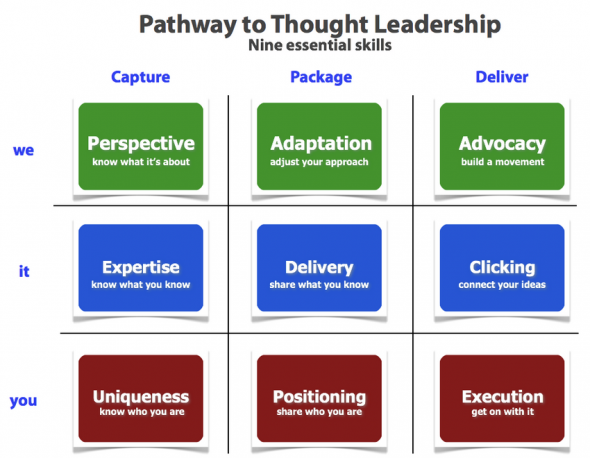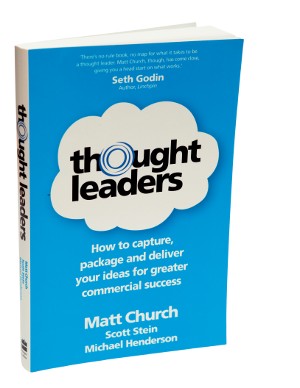Thought Leaders are those people who possess a distinctively original idea, a unique point of view, or an unprecedented insight into their industry.” pg. 14
A special leadership style, the Thought Leader leads as an expert, able to use foresight to build new ideas, create social venture projects and ultimately use them to better communities and provide market solutions.
This book, Thought Leaders, provides the nine essential skills to Thought Leadership, offering tips for better mastering the skills, ideas of strengthening them, and examples of how they may relate to your particular style and situation.

Uniqueness [know who you are]
Find your personal brand and own it. Discover what sets you
apart by finding how you’re wrong, and articulating
how to turn those negatives into positives. Your signature
“is an expression of you, rather than an affectation of who
you’d like to be.” pg. 52. Stand out, don’t bother fitting
in.
Expertise [know what you know]
Craft ideas to achieve clarity, flexibility and integrity.
When delivering ideas, cover the spectrum to intrigue left-
and right-brainers. Thought Leaders are experts because “of
their ability to capture their expertise and share it with
others” pg. 61. Use metaphors and attribute your influencers
to give yourself credibility.
Perspective [see what is really going on]
Develop foresight and look beyond the trends with a more
futuristic viewpoint. Be aware of your environment and
having a sensitivity to sociological technological,
economic, environmental and political factors– The key
is to listen like a leader.

Positioning [share who you are]
Be flexible, and identify the best focus/angle each time
giving your elevator pitch. The three focus levels are
yourself, what you do, and the outcomes. What’s the energy
level required?
Delivery [share what you know]
Tell a story, show an idea, ask a question. There are six
skills to focus on when delivering a message, being a
speaker, author, trainer, mentor, facilitator or coach.
What’s your goal, role and audience?
Adaptation [adjust how you share your ideas]
How do you learn best? Visually? Spoken? Kinesthetically?
Numerically? Abstractly? Assume with any given audience, you
have one of every learner listening and speak to each style.
Execution [get on with it]
The more disciplined you are, then smarter you’ll work.
“Stay on the ball by committing to more and then meeting the
commitments.” pg. 162
Clicking [connect your ideas]
“A great idea that only you like is not that great” pg. 167.
Convince other people you’re idea is really the best by
addressing spoken, and unspoken problems with the idea and
execution. In doing so, you’ll ultimately give you, and your
idea, value.
Advocacy [build a movement]
Challenge your blessings in the beginning, so when the ease
starts to plateau, you can advance to supernova instead of
crashing to burn. Get people talking about you and
collaborate with others to build advocacy within the
organization.
Enterprise your business and market your advantages. If you have the Thought Leadership developmental strategy, you’ll be able to market to your advantage.
Thought Leaders
Matt Church, Scott Stein and Michael Henderson
ISBN 978 1 86950 913 2
HarpinCollins Publishers, Auckland 2011
